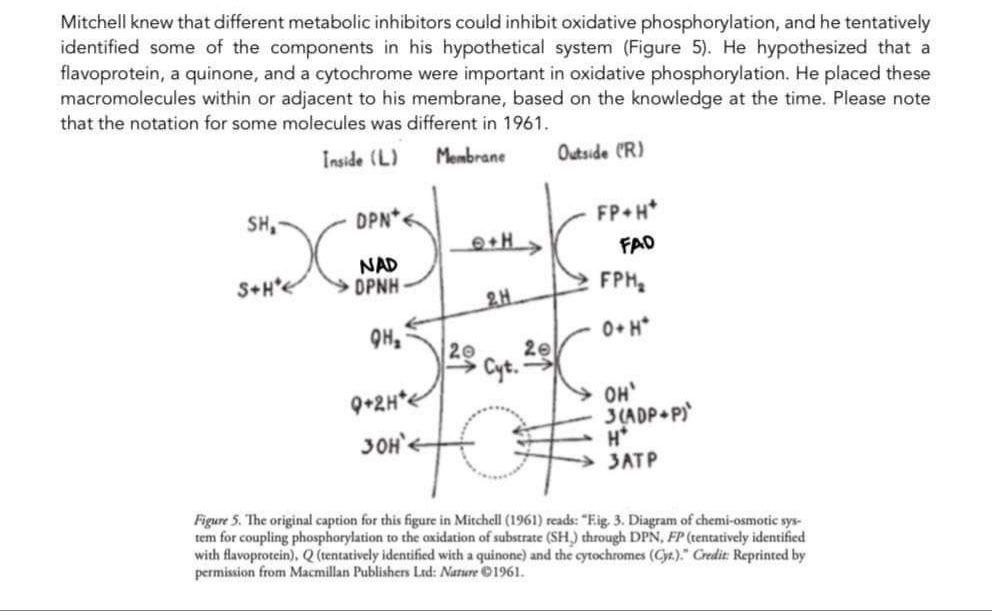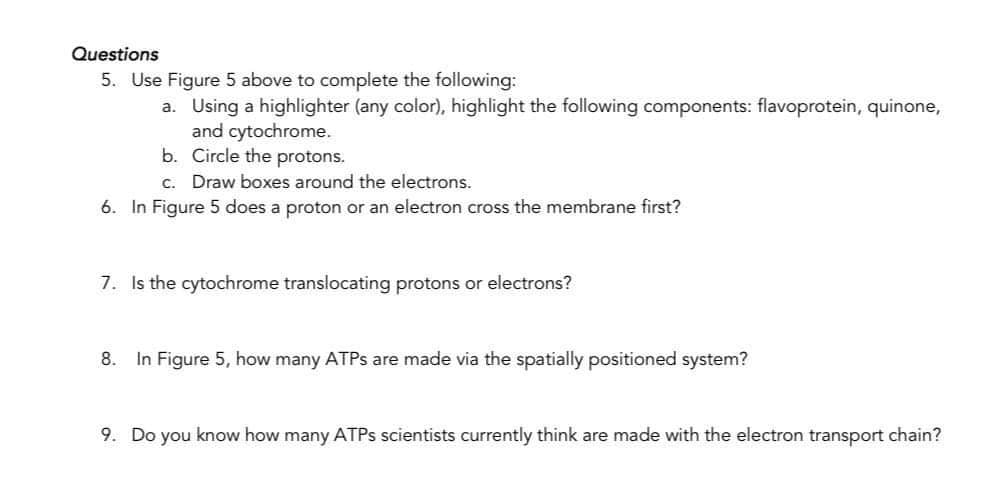Questions 5. Use Figure 5 above to complete the following: a. Using a highlighter (any color), highlight the following components: flavoprotein, quinone, and cytochrome. b. Circle the protons. c. Draw boxes around the electrons. 6. In Figure 5 does a proton or an electron cross the membrane first? 7. Is the cytochrome translocating protons or electrons? 8. In Figure 5, how many ATPs are made via the spatially positioned system? 9. Do you know how many ATPs scientists currently think are made with the electron transport chain?
Questions 5. Use Figure 5 above to complete the following: a. Using a highlighter (any color), highlight the following components: flavoprotein, quinone, and cytochrome. b. Circle the protons. c. Draw boxes around the electrons. 6. In Figure 5 does a proton or an electron cross the membrane first? 7. Is the cytochrome translocating protons or electrons? 8. In Figure 5, how many ATPs are made via the spatially positioned system? 9. Do you know how many ATPs scientists currently think are made with the electron transport chain?
Biochemistry
6th Edition
ISBN:9781305577206
Author:Reginald H. Garrett, Charles M. Grisham
Publisher:Reginald H. Garrett, Charles M. Grisham
Chapter27: Metabolic Integration And Organ Specialization
Section: Chapter Questions
Problem 20P: Figure 27.3 illustrates the response of R (ATP-regenerating) and U (ATP-utilizing) enzymes to energy...
Related questions
Question
Solve full accurate dont use guideline answer ok
Solve full accurate with diagrams okk.

Transcribed Image Text:Mitchell knew that different metabolic inhibitors could inhibit oxidative phosphorylation, and he tentatively
identified some of the components in his hypothetical system (Figure 5). He hypothesized that a
flavoprotein, a quinone, and a cytochrome were important in oxidative phosphorylation. He placed these
macromolecules within or adjacent to his membrane, based on the knowledge at the time. Please note
that the notation for some molecules was different in 1961.
Inside (L)
Membrane
SH₂
S+H*
DPN
NAD
OPNH-
QH₂
9+2H*
30H'<
e+H>
20
2.H
20
Cyt.-
Outside (R)
FP+H*
FAD
FPH₂
0+ H*
OH'
3(ADP+P)
H*
3ATP
Figure 5. The original caption for this figure in Mitchell (1961) reads: "Eig. 3. Diagram of chemi-osmotic sys-
tem for coupling phosphorylation to the oxidation of substrate (SH) through DPN, FP (tentatively identified
with flavoprotein), Q (tentatively identified with a quinone) and the cytochromes (Cyr.)." Credit: Reprinted by
permission from Macmillan Publishers Ltd: Nature ©1961.

Transcribed Image Text:Questions
5. Use Figure 5 above to complete the following:
a. Using a highlighter (any color), highlight the following components: flavoprotein, quinone,
and cytochrome.
b. Circle the protons.
c. Draw boxes around the electrons.
6. In Figure 5 does a proton or an electron cross the membrane first?
7. Is the cytochrome translocating protons or electrons?
8. In Figure 5, how many ATPs are made via the spatially positioned system?
9. Do you know how many ATPs scientists currently think are made with the electron transport chain?
Expert Solution
This question has been solved!
Explore an expertly crafted, step-by-step solution for a thorough understanding of key concepts.
Step by step
Solved in 3 steps with 1 images

Recommended textbooks for you

Biochemistry
Biochemistry
ISBN:
9781305577206
Author:
Reginald H. Garrett, Charles M. Grisham
Publisher:
Cengage Learning

Concepts of Biology
Biology
ISBN:
9781938168116
Author:
Samantha Fowler, Rebecca Roush, James Wise
Publisher:
OpenStax College

Biochemistry
Biochemistry
ISBN:
9781305577206
Author:
Reginald H. Garrett, Charles M. Grisham
Publisher:
Cengage Learning

Concepts of Biology
Biology
ISBN:
9781938168116
Author:
Samantha Fowler, Rebecca Roush, James Wise
Publisher:
OpenStax College